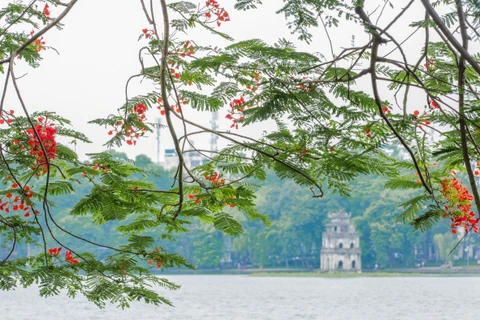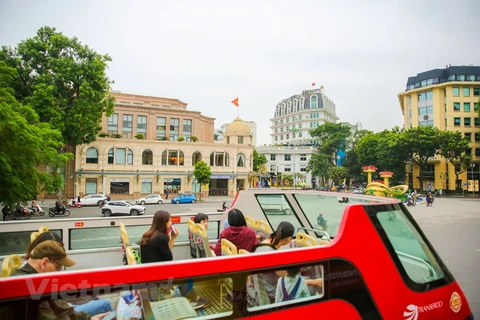Hanoi (VNA) – About 20km southwest of Hanoi, the Cu Da village in Thanh Oai district is renowned for its distinctive cultural space with many well-preserved ancient Vietnamese-style houses as well as traditional vermicelli and soy sauce making.
Lying on the banks of Nhue River, Cu Da still has so many imprints of a typical Vietnamese village of the old time, like century-old trees, old village gates, water wharves, ancient temples and houses that get visitors on a time-travelling trip to go back at least one hundred years.
Unique cultural space
According to Vu Van Than, an 87-year-old elder of the village, genealogies and historical documents show that the village was founded four centuries ago by royal relatives of a Trinh Lord. Then three businessmen who were owners of large textile factories, shops, and transport firms in Hanoi in the 1920s through the 1940s period brought French architecture to the village.
The villagers have always been proud of their home. They used the village’s name as their surname when they lived and worked in Hanoi. “Some of the bourgeois in Hanoi at that time whose names began with the word “Cu” gave the name to Cu Da villagers,” Than said.
Flourishing the most in late 19th and early 20th centuries, Cu Da is now left with about 50 ancient houses designed in typical architecture of the Northern Delta region.
The village was originally planned in an orderly way, with a main road running along the riverbank with big trees planted on one side and houses erected on the other. From the main road, dozens of small alleys paved with slanted bricks run deep into the village like fish bones.
One of the village’s oldest houses is Trinh The Sung’s, built in 1874, where visitors can enjoy architecture dating to the Nguyen Dynasty in the 19th century. The five-room house has sophisticated carvings on its 35 wooden pillars, and its walls were also built with wood and roofed with ancient tiles.
There was also an ancient horizontal lacquered board engraved with Chinese characters and parallel sentences at the ancestral worshiping area in the middle of the house. The house is always cool in summer and warm in winter.
In addition to the ancient houses, the village is also known for many centuries-old temples and pagodas recognised as national heritage relics, one of which is Dan Xa Tac, or Xa Tac Altar, dating back to the early 1900s. Made of precious stones, it was a place of worship where villagers pray for favourable weather and bumper crops.
Traditional craft village
The Cu Da village is famous nationwide for its delicious “mien” (vermicelli) and soy sauce that are being made by nearly 400 local households. The vermicelli making was founded by a villager named Trinh Van Can and has started since around 1950s – 1960s, while the soy sauce making has also dated to the formation of the about-400-years-old village.
Cu Da vermicelli can be easily recognised by its feature of shiny yellow or fine white and thin form. Cu Da vermicelli is made 100 percent from arrowroot, which is ground into flour and mixed with water to make a paste. Then this paste is smeared into thin pancake on the large bamboo trays, steamed, sun-dried, and split into thin, long strings.
The village produces around 15 tonnes of vermicelli every day and the daily output can reach 20 – 25 tonnes during the wedding season or holidays, like Tet – the traditional New Year Festival of Vietnam.
The wholegrain sauce, meanwhile, is made from four main ingredients – glutinous rice, white salt, soybean and water. It must be through the hands of the Cu Da people, the sauce has the right and distinctively delicious taste.
In the past, every family had a jar of wholegrain sauce in their houses to serve the family’s daily meals. But since the precious product became well-known, many families have started to sell it to neighbouring provinces./.



























